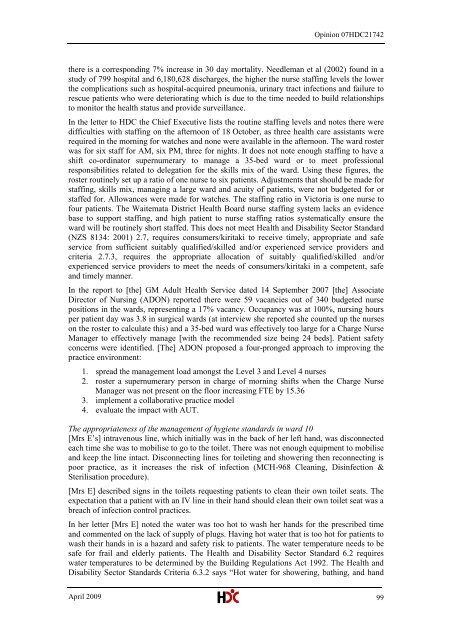North Shore Hospital report - New Zealand Doctor
North Shore Hospital report - New Zealand Doctor
North Shore Hospital report - New Zealand Doctor
Create successful ePaper yourself
Turn your PDF publications into a flip-book with our unique Google optimized e-Paper software.
Opinion 07HDC21742there is a corresponding 7% increase in 30 day mortality. Needleman et al (2002) found in astudy of 799 hospital and 6,180,628 discharges, the higher the nurse staffing levels the lowerthe complications such as hospital-acquired pneumonia, urinary tract infections and failure torescue patients who were deteriorating which is due to the time needed to build relationshipsto monitor the health status and provide surveillance.In the letter to HDC the Chief Executive lists the routine staffing levels and notes there weredifficulties with staffing on the afternoon of 18 October, as three health care assistants wererequired in the morning for watches and none were available in the afternoon. The ward rosterwas for six staff for AM, six PM, three for nights. It does not note enough staffing to have ashift co-ordinator supernumerary to manage a 35-bed ward or to meet professionalresponsibilities related to delegation for the skills mix of the ward. Using these figures, theroster routinely set up a ratio of one nurse to six patients. Adjustments that should be made forstaffing, skills mix, managing a large ward and acuity of patients, were not budgeted for orstaffed for. Allowances were made for watches. The staffing ratio in Victoria is one nurse tofour patients. The Waitemata District Health Board nurse staffing system lacks an evidencebase to support staffing, and high patient to nurse staffing ratios systematically ensure theward will be routinely short staffed. This does not meet Health and Disability Sector Standard(NZS 8134: 2001) 2.7, requires consumers/kiritaki to receive timely, appropriate and safeservice from sufficient suitably qualified/skilled and/or experienced service providers andcriteria 2.7.3, requires the appropriate allocation of suitably qualified/skilled and/orexperienced service providers to meet the needs of consumers/kiritaki in a competent, safeand timely manner.In the <strong>report</strong> to [the] GM Adult Health Service dated 14 September 2007 [the] AssociateDirector of Nursing (ADON) <strong>report</strong>ed there were 59 vacancies out of 340 budgeted nursepositions in the wards, representing a 17% vacancy. Occupancy was at 100%, nursing hoursper patient day was 3.8 in surgical wards (at interview she <strong>report</strong>ed she counted up the nurseson the roster to calculate this) and a 35-bed ward was effectively too large for a Charge NurseManager to effectively manage [with the recommended size being 24 beds]. Patient safetyconcerns were identified. [The] ADON proposed a four-pronged approach to improving thepractice environment:1. spread the management load amongst the Level 3 and Level 4 nurses2. roster a supernumerary person in charge of morning shifts when the Charge NurseManager was not present on the floor increasing FTE by 15.363. implement a collaborative practice model4. evaluate the impact with AUT.The appropriateness of the management of hygiene standards in ward 10[Mrs E‘s] intravenous line, which initially was in the back of her left hand, was disconnectedeach time she was to mobilise to go to the toilet. There was not enough equipment to mobiliseand keep the line intact. Disconnecting lines for toileting and showering then reconnecting ispoor practice, as it increases the risk of infection (MCH-968 Cleaning, Disinfection &Sterilisation procedure).[Mrs E] described signs in the toilets requesting patients to clean their own toilet seats. Theexpectation that a patient with an IV line in their hand should clean their own toilet seat was abreach of infection control practices.In her letter [Mrs E] noted the water was too hot to wash her hands for the prescribed timeand commented on the lack of supply of plugs. Having hot water that is too hot for patients towash their hands in is a hazard and safety risk to patients. The water temperature needs to besafe for frail and elderly patients. The Health and Disability Sector Standard 6.2 requireswater temperatures to be determined by the Building Regulations Act 1992. The Health andDisability Sector Standards Criteria 6.3.2 says ―Hot water for showering, bathing, and handApril 2009 99
















